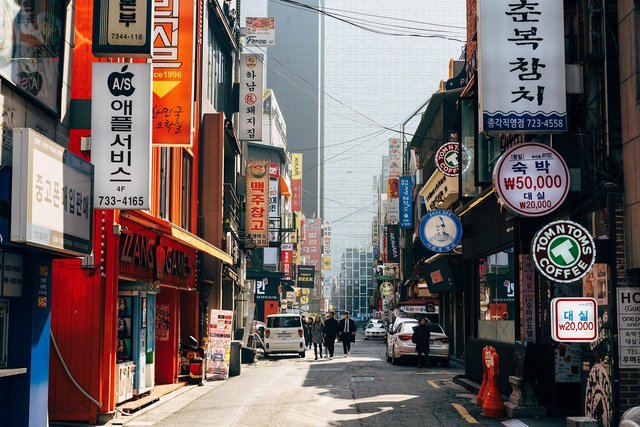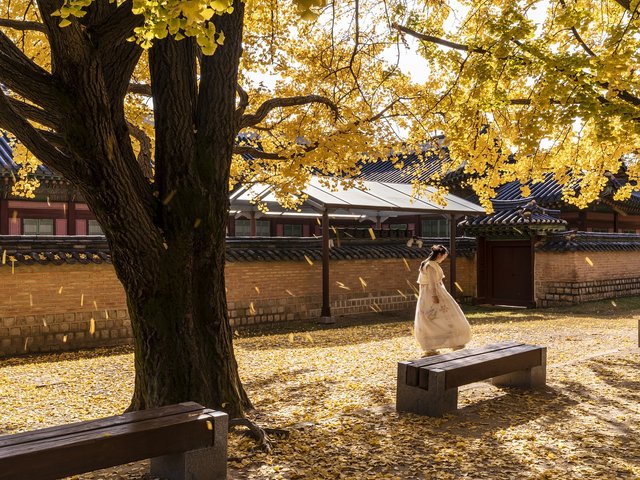한국의 문화[Culture of Korea.]
한반도와 만주 지역의 구석기 시대는 약 50만 년 전에 시작되었습니다.[1][2][3] 한국에서 알려진 최초의 도자기는 기원전 8000년경으로 거슬러 올라가며, 신석기시대는 기원전 6000년 이후에 시작되고 청동기시대는 기원전 2000년,[4][5][6] 철기시대는 기원전 700년경이다. [The Lower Paleolithic era in the Korean Peninsula and Manchuria began roughly half a million years ago.[1][2][3] The earliest known Korean pottery dates to around 8000 BC, and the Neolithic period began after 6000 BC, followed by the Bronze Age by 2000 BC,[4][5][6] and the Iron Age around 700 BC.]

마찬가지로 김양기가 감수하고 강덕상, 중사나에, 나카야마 기요타카가 편찬한 『조선사』에 따르면 구석기인들은 현 조선인의 직계조상이 아니라 직계조상이다. 기원전 2000년경의 신석기 시대 사람들로 추정됩니다.[7] [ Similarly, according to The History of Korea, supervised by Kim Yang-ki and edited by Kang Deoksang, Jung Sanae, and Nakayama Kiyotaka, the Paleolithic people are not the direct ancestors of the present Korean (Chosun) people, but their direct ancestors are estimated to be the Neolithic People of about 2000 BC.[7]]

삼국유사(1280년대)에 기록된 신화 이야기에 따르면 고조선(고조선) 왕국은 기원전 2333년에 북조선과 남만주에 세워졌습니다.[8][9][10] 기원전 12세기에 중국 상나라의 왕자 기자가 기자 조선을 세웠다고 합니다.[11][12] 고조선에 대한 최초의 문헌 기록은 기원전 7세기 초부터 찾아볼 수 있다.[13][14] 기원전 3세기경에 남한에 진나라가 형성되었다. 기원전 2세기에 기자조선이 위만조선으로 바뀌었고, 세기말에 중국 한나라에 함락되었다. 이로 인해 고조선이 멸망하고 이후의 철기 시대에 걸친 조삼국 시대인 전국 시대가 이어졌습니다. [According to the mythic account recounted in the Samguk Yusa (1280s), the Gojoseon (Old Joseon) kingdom was founded in northern Korea and southern Manchuria in 2333 BC.[8][9][10] In the 12th century BC Gija, a prince from the Shang dynasty of China, purportedly founded Gija Joseon.[11][12] The first written historical record on Gojoseon can be found from the early 7th century BC.[13][14] The Jin state was formed in southern Korea by the 3rd century BC. In the 2nd century BC, Gija Joseon was replaced by Wiman Joseon, which fell to the Han dynasty of China near the end of the century. This resulted in the fall of Gojoseon and led to succeeding warring states, the Proto–Three Kingdoms period that spanned the later Iron Age.]

From the 1st century, Goguryeo (고려), Baekje (백제), and Silla (실라) grew to control the peninsula and Manchuria as the Three Kingdoms of Korea (57 BC–668 AD), until unification by Silla in 676. In 698, King Go established the Kingdom of Balhae (c.f. modern Bohai Sea) in old territories of Goguryeo,[15][16] which led to the Northern and Southern States period (698–926) of Balhae and Silla coexisting.
In the late 9th century, Silla was divided into the Later Three Kingdoms (892–936), which ended with the unification by Wang Geon's Goryeo dynasty. Meanwhile, Balhae fell after invasions by the Khitan-led Liao dynasty and the refugees including the last crown prince emigrated to Goryeo, where the crown prince was warmly welcomed and included into the ruling family by Wang Geon, thus unifying the two successor states of Goguryeo.[17][18] During the Goryeo period, laws were codified, a civil service system was introduced, and culture influenced by Buddhism flourished. However, Mongol invasions in the 13th century brought Goryeo under the influence of the Mongol Empire and the Yuan dynasty until the mid-14th century.[19][20]
In 1392, General Yi Seong-gye established the Joseon dynasty (1392–1897) after a coup d'état that overthrew the Goryeo dynasty in 1388. King Sejong the Great (1418–1450) implemented numerous administrative, social, scientific, and economic reforms, established royal authority in the early years of the dynasty, and personally created Hangul, the Korean alphabet.
After enjoying a period of peace for nearly two centuries, the Joseon dynasty faced foreign invasions and internal factional strife from 1592 to 1637. Most notable of these invasions is the Japanese invasions of Korea, which marked the end of the Joseon dynasty's early period. The combined force of Ming dynasty of China and the Joseon dynasty repelled these Japanese invasions, but at a cost to the countries. Henceforth, Joseon gradually became more and more isolationist and stagnant. By the mid 19th century, with the country unwilling to modernize, and under encroachment of European powers, Joseon Korea was forced to sign unequal treaties with foreign powers. After the assassination of Empress Myeongseong in 1895, the Donghak Peasant Revolution, and the Gabo Reforms of 1894 to 1896, the Korean Empire (1897–1910) came into existence, heralding a brief but rapid period of social reform and modernization. However, in 1905, the Korean Empire signed a protectorate treaty and in 1910, Japan annexed the Korean Empire.
Korean resistance manifested in the widespread March 1st Movement of 1919. Thereafter the resistance movements, coordinated by the Provisional Government of the Republic of Korea in exile, became largely active in neighboring Manchuria, China proper, and Siberia, influenced by Korea's peaceful demonstrations. Figures from these exile organizations would become important in post-WWII Korea.
After the end of World War II in 1945, the Allies divided the country into a northern area (protected by the Soviets) and a southern area (protected primarily by the United States). In 1948, when the powers failed to agree on the formation of a single government, this partition became the modern states of North and South Korea. The peninsula was divided at the 38th Parallel: the "Republic of Korea" was created in the south, with the backing of the US and Western Europe, and the "Democratic People's Republic of Korea" in the north, with the backing of the Soviets and the communist People's Republic of China. The new premier of North Korea, Kim Il-sung, launched the Korean War in 1950 in an attempt to reunify the country under Communist rule. After immense material and human destruction, the conflict ended with a cease-fire in 1953. In 1991, both states were accepted into the United Nations. In 2018, the two nations agreed to work toward a final settlement to formally end the Korean War.
While both countries were essentially under military rule after the war, South Korea eventually liberalized. Since 1987 it has had a competitive electoral system. The South Korean economy has prospered, and the country is now considered to be fully developed, with a similar capital economic standing to Western Europe, Japan, and the United States.
North Korea has maintained totalitarian militarized rule, with a personality cult constructed around the Kim family. Economically, North Korea has remained heavily dependent on foreign aid. Following the end of the Soviet Union, that aid collapsed precipitously. The country's economic situation has been quite marginal since.